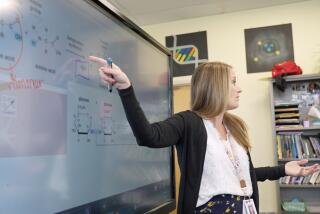Solving Schools’ Problems
- Share via
Re “Denying Easy Diplomas Won’t Solve the Problem,” June 20.
I also teach English in a large (3,500 students) public high school in Los Angeles Unified School District, and in my 20 years of teaching, I have never encountered a class like the one Doug Lasken described. I too have had my share of unmotivated, unskilled and disaffected teenagers, as have my colleagues. However, I have always believed it is the teacher’s responsibility to establish and maintain classroom control and to create curriculum that is interesting, meaningful and productive for students. Based solely on the information he provided in the essay, I would have to assume that the author is an inexperienced teacher for whom I recommend additional training in classroom management and English course work in the content area.
The classroom situation described does raise another issue of paramount importance for our public school system: the need for effective and qualified teachers. How can we attract the best and brightest of our college graduates when the entry-level job at a computer company pays up to twice as much as a beginning teacher’s salary? Our society values people who can program machines, fix objects and produce attractive documents more than it values people who inspire, transform, instruct and nurture human beings. Until the public is willing to pay the price for training and employing quality teachers, it will not see any significant improvement in test scores or student productivity, regardless of the number of reform documents the Legislature dictates.
ELISA PULIDO-RAGUS, English Department Chair, Granada Hills High School
*
There are hundreds of thousands of kids in our high schools today who are nonstudents. All the paper standards, exit exams and projects to end social promotion won’t save many of them.
If these students were given an alternative to an academic high school program, an alternative where they learned basic academic skills but also learned auto repair, carpentry, electrical work, word processing, hair styling, food service or some of the hundreds of other areas where jobs are plentiful, we’d probably solve some real problems. No longer would teachers be forced to water down their academic courses with the hope of turning around a few of the nonacademic students. The nonacademic students would leave high school with real job skills.
The myth that we need to teach all students rigorous academics is nonsense. It is about time that we really help students who do not conform to the academic treadmill.
STEVEN B. OPPENHEIMER, Biology Professor, Cal State Northridge
*
I think Lasken’s “Perspective on Education” is right on target. Take his description and change the number of students in class from 20 to 40-plus and you’ll have a pretty good idea of what my children experienced. What is the solution? Since it is heresy to suggest that Proposition 13 has had anything to do with the precipitous decline in California’s public education system, but rather only to blame immigrants, minorities and “secular humanists,” the solution is to do away with public education in this state. Only those fit to go to school should be allowed to. Eliminate all undesirables.
Without public education, we could return to the days of church-sponsored schools and home schooling. No child would ever have to be subjected to the demonic influences rampant in public schools. We would return to the moral standards on which this country was founded and the quality of learning would again rise to the levels that once made America great. For those children whose parents cannot afford to educate them, we could provide work training by eliminating minimum-age laws for child labor. Children from an early age too poor or with no English skills or handicapped or in any other way unfit for education could be apprenticed to some skilled laborer to learn a trade.
Now there’s a vision of California’s educational system for the future.
ROBERT B. HARRIS, Lancaster
More to Read
Sign up for Essential California
The most important California stories and recommendations in your inbox every morning.
You may occasionally receive promotional content from the Los Angeles Times.










